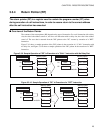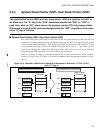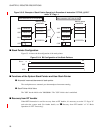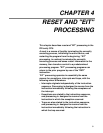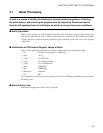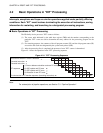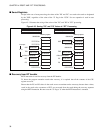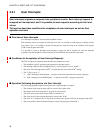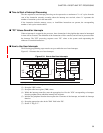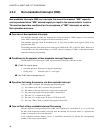
33
CHAPTER 4 RESET AND "EIT" PROCESSING
4.1 Reset Processing
A reset is a means of forcibly terminating the currently executing process, initializing
the entire device, and restarting the program from the beginning. Resets are used to
start the LSI operating from its initial state, as well as to recover from error conditions.
■ Reset Operations
When a reset is applied, the CPU terminates processing of the instruction executing at that time and goes
into inactive status until the reset is canceled. When the reset is canceled, the CPU initializes all internal
registers and starts execution beginning with the program indicated by the new value of the program
counter (PC).
■ Initialization of CPU Internal Register Values at Reset
When a reset is applied, the FR family CPU initializes internal registers to the following values.
• PC: Word data stored at address "000FFFFC
H
"
• ILM: "01111
B
"
• T Flag: "0" (trace OFF)
• I Flag: "0" (interrupt disabled)
• S Flag: "0" (use SSP pointer)
• TBR: "000FFC00
H
"
• SSP: "00000000
H
"
• R00 to R14: Undefined
• R15: SSP
For a description of built-in functions following a reset, refer to the Hardware Manual provided with each
FR family device.
■ Reset Priority Level
Resets have a higher priority than all "EIT" operations.



